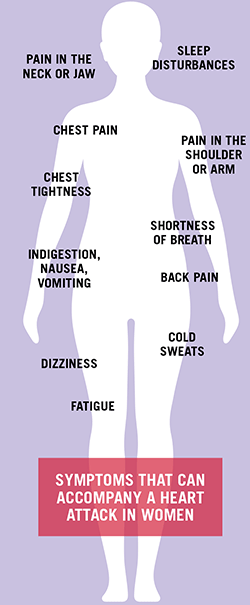
Heart attacks are different for women. Learn how to protect yourself.

Heart disease is the leading cause of death in women—although fewer than half of women recognize that fact, according to research by the American Heart Association. Because women often don’t recognize the symptoms of a heart attack—which can be quite different from a man’s—they may not take steps to prevent one or get treatment quickly when one occurs. An estimated 80 percent of all heart disease, including heart attacks, is preventable. “Unfortunately, many women don’t seek preventive care early enough,” says Delphine Tang, DO, an interventional cardiologist at Robert Wood Johnson University Hospital (RWJUH) Rahway and a member of RWJBarnabas Health Medical Group.
“We have all this great medicine and innovative technology,” Dr. Tang says. “But we cannot utilize it if we aren’t identifying the women who need it. More women should be coming to talk to their doctors about their heart risks.”
What Causes a Heart Attack?
Heart attacks occur when the heart’s blood supply is blocked, cutting off the oxygen the heart muscle needs to survive. The most common cause of a heart attack is coronary heart disease (CHD), sometimes called coronary artery disease (CAD), when plaque—made up of several substances in the blood, including fat and cholesterol—builds up in one or more of the heart’s arteries, narrowing or hardening them.
Less often, a spasm in a coronary artery that closes off blood flow to the heart muscle can lead to a heart attack. This can occur as a result of using tobacco or stimulants such as cocaine. Recently, doctors have found that COVID-19 infection can also damage the heart. Too often, patients have delayed getting treatment for a heart attack due to fear of going to the hospital during the pandemic.
Who’s at Risk for a Heart Attack?
Risk factors for a future heart attack can include:
- Age (women are at greater risk after menopause)
- High blood pressure
- High cholesterol
- Obesity
- Diabetes
- Smoking
- Excessive alcohol use
- Unhealthy diet
- Lack of exercise/sedentary lifestyle
- Family history
Having certain autoimmune conditions, such as rheumatoid arthritis or lupus, can also raise the risk of heart attack.
What Can Women do to Protect Themselves?
“The more information you and your doctors have about your risk factors and the state of your heart health, the more you can minimize your chance of having a heart attack,” says Dr. Tang. Women should seek preventive care early, especially if they smoke or have a family history of heart disease.
Preventive measures include:
A healthy weight and diet: Include fresh fruits and vegetables and avoid processed foods and excess sugar.
Regular screening tests: These should include lipid panels (cholesterol tests), as well as blood sugar and high blood pressure screening.
Early treatment: If needed, blood pressure or cholesterol medication can be prescribed. “We have to start treating people for these issues early, because we’re starting to see heart attacks in younger women,” Dr. Tang says.
Regular exercise: “Every woman should exercise for 30 minutes on most days of the week, at moderate
intensity,” says Dr. Tang. Exercise also helps reduce stress, which contributes to overall health.
6 Steps to a Healthier Heart

- Go for a walk. Walking for just 30 minutes a day can lower your risk for heart attack and stroke.
- Get enough sleep. Researchers found that people who have a healthy sleep duration (seven to eight hours) are less likely to have heart disease.
- Go to bed at the same time each night. One study showed that women who went to bed at the same time every day lost about two pounds of body fat over a six-week period, compared to women who had greater variations in their bedtimes.
- Consider getting a pet. Several studies have shown that dog owners have lower blood pressure, perhaps because their pets have a calming effect on them and they get more exercise.
- Brush your teeth twice a day for at least two minutes. One study found that people who do this have a greatly reduced risk of heart disease, possibly because periodontal disease is linked to heart disease.
- Quit smoking. After one year, you’ll have cut your risk of coronary disease by 50 percent. To learn about a free program to help you quit smoking, call 833-795-QUIT (833-795-7848) or visit the Nicotine and Tobacco Recovery Program .
What’s Different for Women?
Women and men don’t necessarily have the same heart attack symptoms. “Chest pain can be a symptom of a heart attack, but it’s not the main or only one,” says interventional cardiologist Delphine Tang, DO. “For women, the symptoms are harder to tease out. They may not have chest pain at all.”
Because these symptoms are more subtle than sharp, sudden chest pain, many women ignore them or mistakenly attribute such signs to the flu, indigestion or just the aches and pains of getting older.
Whoever your heart beats for, our hearts beat for you. To find a top cardiovascular specialist at RWJUH Rahway, call 888-724-7123 or visit Heart and Vascular Care.